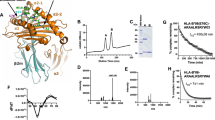Abstract
EFFICIENT egress of major histocompatibility complex (MHC) class I molecules from the endoplasmic reticulum (ER) depends on peptide binding1–7. For MHC class II molecules, invariant chain (Ii) promotes ER exit of newly assembled, peptide-free dimers8–14. This raises the question of whether a mechanism exists elsewhere in the cell that dictates selective expression of peptide-associated class II molecules. We report here that dissociation of MHC class II–Ii complexes at low pH and physiological temperature leads to inclusion of empty class II in protein aggregates, and that this aggregation is specifically prevented by peptide binding. Combined with data showing that antigen exposure increases cell surface class II expression on living cells by a post-translational mechanism12, these results provide evidence for peptide-dependent intracellular editing of class II dimers, which limits surface expression of empty molecules unsuitable for antigen-specific T-cell activation.
This is a preview of subscription content, access via your institution
Access options
Subscribe to this journal
Receive 51 print issues and online access
$199.00 per year
only $3.90 per issue
Buy this article
- Purchase on Springer Link
- Instant access to full article PDF
Prices may be subject to local taxes which are calculated during checkout
Similar content being viewed by others
References
Salter, R. D. & Cresswell, P. EMBO J. 5, 943–949 (1986).
Townsend, A. et al. Nature 340, 443–448 (1989).
Spies, T. et al. Nature 348, 744–747 (1990).
Spies, T. & DeMars, R. Nature 351, 323–324 (1991).
Lie, W. R. et al. Nature 344, 439–441 (1990).
Bikoff, E. K., Otten, G. R. & Robertson, E. J. Eur. J. Immun. 21, 1997–2004 (1991).
Degen, E. & Williams, D. B. J. Cell Biol. 112, 1099–1115 (1991).
Claesson-Welch, L. & Peterson, P. A. J. Immun. 135, 3551–3557 (1985).
Roche, P. A. & Cresswell, P. Nature 345, 615–618 (1990).
Teyton, L. et al. Nature 348, 39–44 (1990).
Layet, C. & Germain, R. N. Proc. natn. Acad. Sci. U.S.A. 88, 2346–2350 (1991).
Germain, R. N. & Hendrix, L. R. Nature 353, 134–139 (1991).
Anderson, M. S. & Miller, J. Proc. natn. Acad. Sci. U.S.A. 89, 2282–2286 (1992).
Roche, P. A. & Cresswell, P. Proc. natn. Acad. Sci. U.S.A. 88, 3150–3154 (1991).
Sadegh-Nasseri, S. & Germain, R. N. Nature 353, 167–170 (1991).
Stern, J. J. & Wiley, D. C. Cell 68, 465–477 (1992).
Wettstein, D. A., Boniface, J. J., Reay, P. A., Schild, H. & Davis, M. M. J. exp. Med. 174, 219–228 (1991).
Braunstein, N. S., Germain, R. N., Loney, K. & Berkowitz, N. J. Immun. 145, 1635–1645 (1990).
Davidson, H. W., Reid, P. A., Lanzavecchia, A. & Watts, C. Cell 67, 105–116 (1991).
Neefjes, J. J. & Ploegh, H. L. EMBO J. 11, 411–416 (1992).
Blum, J. S. & Cresswell, P. Proc. natn. Acad. Sci. U.S.A. 85, 3975–3979 (1988).
Peterson, M. & Miller, J. Nature 345, 172–174 (1990).
Viville, S. et al. Cell 72, 635–648 (1993).
Bikoff, E. K. et al. J. exp. Med. 177, 1699–1712 (1993).
Mellins, E. et al. Nature 343, 71–74 (1990).
Buus, S., Sette, A., Colons, S. M., Miles, C. & Grey, H. M. Science 235, 1353–1358 (1987).
Lanzavecchia, A., Reid, P. A. & Watts, C. Nature 357, 249–252 (1992).
Riberdy, J. M., Newcomb, J. R., Surman, M. J., Barbosa, J. A. & Cresswell, P. Nature 360, 474–477 (1992).
Sette, A. et al. Science 258, 1801–1804 (1992).
Gorga, J. C., Horejsi, V. Johnson, D. R., Raghupathy, R. & Strominger, J. L. J. biol. Chem. 262, 16087–16094 (1987).
Oi, V., Jones, P. P., Goding, J. W., Herzenberg, L. A. & Herzenberg, L. A. Curr. Top. Microbiol. Immun. 81, 115–120 (1978).
Ozato, K., Mayer, N. M. & Sachs, D. H. J. Immun. 124, 533–540 (1980).
Koch, N., Koch, S. & Hämmerling, G. J. Nature 299, 644–645 (1982).
Mehringer, J. H., Harris, M. R., Kindle, C. S., McCourt, D. W. & Cullen, S. E. J. Immun. 146, 920–927 (1991).
Sant, A. J., Hendrix, L. R., Coligan, J. E., Maloy, W. L. & Germain, R. N. J. exp. Med. 174, 799–808 (1991).
Kappler, J. W., Skidmore, B., White, J. & Marrack, P. J. exp. Med 153, 1198–1214 (1981).
Ozato, K., Epstein, S. L., Henkart, P., Hansen, T. H. & Sachs, D. H. Transplantation 34, 113–120 (1982).
Author information
Authors and Affiliations
Rights and permissions
About this article
Cite this article
Germain, R., Rinker, A. Peptide binding inhibits protein aggregation of invariant-chain free class II dimers and promotes surface expression of occupied molecules. Nature 363, 725–728 (1993). https://doi.org/10.1038/363725a0
Received:
Accepted:
Issue Date:
DOI: https://doi.org/10.1038/363725a0
This article is cited by
-
Heterodimer HLA-DM Fused with Constant Fragment of the Heavy Chain of the Human Immunoglobulin Accelerates Influenza Hemagglutinin HA306–318 Loading to HLA-DR1
Bulletin of Experimental Biology and Medicine (2016)
-
Roles for major histocompatibility complex glycosylation in immune function
Seminars in Immunopathology (2012)
-
HLA-DM captures partially empty HLA-DR molecules for catalyzed removal of peptide
Nature Immunology (2011)
-
Conformational heterogeneity of MHC class II induced upon binding to different peptides is a key regulator in antigen presentation and epitope selection
Immunologic Research (2010)
-
Peptide loading in the endoplasmic reticulum accelerates trafficking of peptide: MHC class II complexes in B cells
Journal of Biomedical Science (1999)
Comments
By submitting a comment you agree to abide by our Terms and Community Guidelines. If you find something abusive or that does not comply with our terms or guidelines please flag it as inappropriate.



